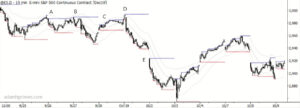Sometimes, reading market action is about putting the pieces together… building a big picture from the composite of small bits of information that might not seem terribly meaningful by themselves.
For the past several weeks, swing trading in currencies has been difficult. We’ve seen many setups trigger, but fail almost immediately with poor followthrough. For swing traders, surviving an environment like this with minimal damage is important because it allows us to be ready to capitalize on a better environment when one emerges.
Of course, knowing when things have changed is the key. No one is going to wave a big flag that says “Hey, it’s ok to trade bigger now!” Instead, we have to figure it out for ourselves.
The AUDUSD has been the poster child for poor followthrough in currencies. If you look at the weekly chart, you see (starting from the arrow marked A) many weekly doji-type bars–or at least bars that opened and closed somewhere in the middle of the range. Each week traded pretty much to the highs and lows of the range, but there was no conviction beyond the range.
This leaves long shadows on candlesticks. (Some people use the sloppier terminology “wicks”, but I believe “shadows” is more correct and in keeping with the spirit of the Japanese origin of these charts.) A single shadow on a single candle probably isn’t terribly meaningful, but we can start to see a story when many shadows stop in the same area. Symmetry or lack of symmetry can tell us something–if we see a lot of long lower shadows it might be indicative of accumulation. In the chart of the AUD, more or less symmetrical shadows show a market in relative equilibrium, with no one willing to buy above or sell below the recent range.
This is how markets get ‘stuck’ in price ranges, and these are ranges where we generally see poor followthrough.
The last weekly candle on the chart, marked B, might be different. This gives us a chance of transitioning into an environment that sees better trends and more directional trades. (See my old blog on this topic.) Now we watch, but we also have some guidelines to shape our approach and action in this market, and perhaps in other currencies.
Noticing when a market pattern is changing is one of the keys to successful trading.

